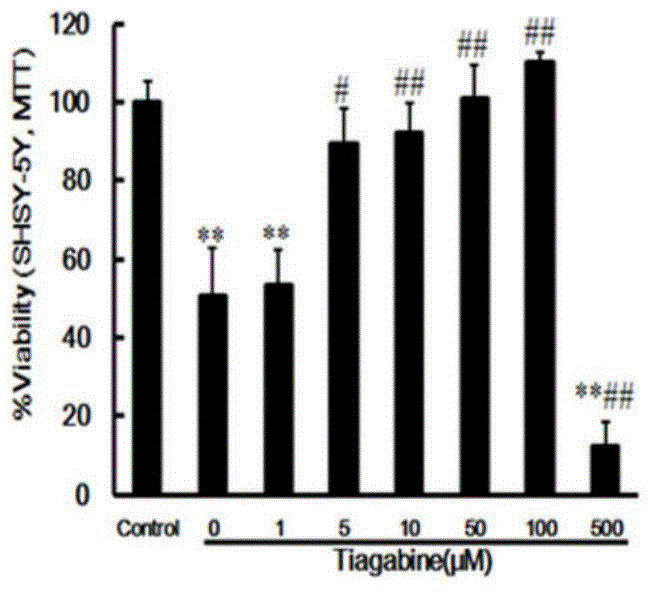Applications of tiagabine in preparing medicines for treating dopaminergic neuron injuries
A neuron damage and dopaminergic technology, applied in the field of antiepileptic drug tiagabine, can solve the problems of high cost and decreased efficacy, and achieve the effect of protecting dopaminergic nerve cells
- Summary
- Abstract
- Description
- Claims
- Application Information
AI Technical Summary
Problems solved by technology
Method used
Image
Examples
Embodiment 1
[0045] Example 1: BV2 cells were cultured, treated with drugs, and the activity of NF-κB in the cells was analyzed
[0046] 1) NF-κB nuclear localization study: BV2 microglial cells were cultured in DMEM / F12+5% fetal bovine serum medium; PBS; LPS (1 μg / ml); Tiagabine (50 μM); Tiagabine pre-administration were given according to groups After 1 hour of LPS administration, the nuclear localization of NF-κB (p65 subunit) was observed by immunofluorescence staining and laser confocal imaging techniques; figure 1 Shown in A: In the resting state, NF-κB (p65 subunit) is mainly localized in the cytoplasm; 1 hour after LPS stimulation, the nuclear localization of NF-κB increases, indicating that the pathway is activated; pre-administration of Tiagabine can reduce The nuclear import of NF-κB inhibits the activation of inflammatory pathways; while single administration of Tiagabine has no effect on the nuclear localization of NF-κB.
[0047] 2) Cellular NF-κB activity was detected by a ...
Embodiment 2
[0048] Example 2: Collect the conditioned medium of BV2 cells, add the cultured human dopaminergic cell line SH-SY5Y cells, and analyze the viability of SH-SY5Y cells
[0049] BV2 microglial cells were given PBS; LPS (1 μg / ml); Tiagabine (50 μM); Tiagabine was pre-administered for 1 hour + LPS, and 24 hours later, the medium of each group was added to SH-SY5Y cells for conditional culture. After 24 hours, the activity of SH-SY5Y cells was detected by MTT method; figure 2 As shown, the viability of conditionally cultured SH-SY5Y cells in the LPS stimulation group was significantly decreased; pre-administration of different doses of Tiagabine (5, 10, 50, 100 μM) before LPS stimulation could significantly improve the viability of conditionally cultured SH-SY5Y cells , but 500μM Tiagabine showed significant toxicity to the cells, **P<0.01 compared with the control group; #p<0.05, ##p<0.01 compared with the LPS group.
Embodiment 3
[0050] Example 3: Intraperitoneal injection of MPTP or substantia nigra stereotaxic injection of LPS, combined with Tiagabine pre-administration, analysis of microglial activation
[0051] 1) Microglia activation after intraperitoneal injection of drugs in mice: C57BL / 6 mice aged 10-14 weeks were used in the experiment, and the experiment was divided into three groups: normal saline control group; MPTP group; co-administration of Tiagabine and MPTP Group. MPTP acute model establishment method: intraperitoneal injection of MPTP·HCl (20 mg / kg) every 2 hours, a total of 4 times; normal saline control group intraperitoneal injection of the same volume of normal saline; Tiagabine (1 mg / kg) was injected intraperitoneally 1 hour before. On the second day after the establishment of the model, the brains of the mice were perfused, fixed, dehydrated, and frozen for sectioning. The striatum and substantia nigra were stained for the microglial marker Iba1 by immunofluorescent staining, a...
PUM
 Login to View More
Login to View More Abstract
Description
Claims
Application Information
 Login to View More
Login to View More - R&D
- Intellectual Property
- Life Sciences
- Materials
- Tech Scout
- Unparalleled Data Quality
- Higher Quality Content
- 60% Fewer Hallucinations
Browse by: Latest US Patents, China's latest patents, Technical Efficacy Thesaurus, Application Domain, Technology Topic, Popular Technical Reports.
© 2025 PatSnap. All rights reserved.Legal|Privacy policy|Modern Slavery Act Transparency Statement|Sitemap|About US| Contact US: help@patsnap.com



